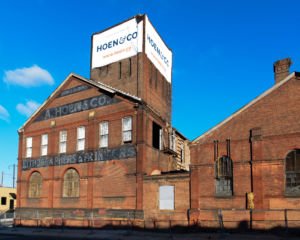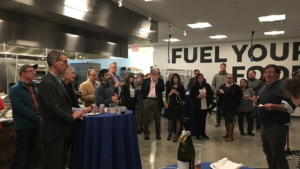NTCIC is thrilled to announce the successful financial closing to provide capital for the adaptive reuse of the historic Hoen Lithograph buildings located in East Baltimore, Maryland. Vacant for over 30 years, the buildings will be transformed into a community-serving resource for workforce development, education, and entrepreneurship.
This week’s financial closing marks the end of a multi-year predevelopment process and the beginning of one of the most significant economic investments in this section of Baltimore in decades. The complex financing package included a variety of state and local grants, over $4.44 million in federal Historic Tax Credits and $24.25 million in New Markets Tax Credit allocation, $10 million of which was provided by NTCIC.
With its sources of funding successfully in place, the project will be able to continue the year-long renovation process to bring the former lithography printing facility back to life. When construction is complete in 2020, the Hoen buildings will become the Center for Neighborhood Innovation–a new model for community transformation. It will co-locate and grow workforce development programs, educational training, neighborhood revitalization advocates, and nonprofits committed to strengthening the local neighborhood.

The Hoen Lithograph Buildings in East Baltimore, Maryland will see a new life in the coming years
A Historic Moment for East Baltimore
The 85,000-SF Hoen & Co. Complex, initially constructed in 1885 in Baltimore, MD, is the last remaining site of the oldest continuously operating lithographer in the United States. Known for their precision and high-quality work that elevated the medium, the Hoen & Co. lithographers specialized in cartographic, scientific, and pictorial illustration, producing maps that were influential in the settlement of the west and setting national boundaries. Their maps were used in the National Geographic Society’s first bound atlas and comprised the full collection of insert maps in the National Geographic magazine.
They also frequently partnered with the Johns Hopkins University Department of Art as Applied to Science in the creation of extraordinarily detailed medical illustrations. At its peak, the Hoen buildings supported thousands of jobs, many of which were filled by residents of the surrounding blue-collar neighborhood of Collington Square. However, by the time the company succumbed to bankruptcy in 1981, the area was in sharp decline.
The buildings sat vacant and underutilized for nearly four decades until the project team envisioned a new future for the complex. The $28.3 million revitalization of the Hoen Lithograph buildings joins other highly impactful neighborhood development efforts, including the nonprofit headquarters for Humanim located in the former American Brewery building, a 2009 NTCIC investment.
“Catalytic developments of this nature come with some of the most challenging hurdles from a financing perspective and would not have been possible without incentives like the New Markets or Historic Tax Credit,” said Christina Smith, Project Manager for NTCIC. “It was an honor to play a part in making the Center for Neighborhood Innovation possible.”
Mission-Aligned Historic Development
The Hoen Lithograph buildings will be a game changer for workforce development initiatives and the lives of many in Baltimore. It will bring together mission-aligned nonprofit organizations and trade associations with successful track records of supporting the growth and prosperity of the local community. The buildings will be anchored by Strong City Baltimore, a nonprofit partner in the overall development effort, which will take space within the largest historic building in the complex. This organization provides a wealth of community-centric programming such as literacy training, early childhood education, is the largest local sponsor of the AmeriCorps VISTA program, and provides fiscal sponsorship for over 100 local nonprofits. The Hoen Lithograph buildings will be the location for their new headquarters, allowing them to continue their work across this city, scale up their support of area nonprofits, and provide additional focus to the residents of East Baltimore.
Associated Builders and Contractors (ABC), a national construction industry trade association providing workforce training, will also serve as an anchor tenant. Founded in 1950, the company provides training to over 476,000 individuals annually and connects program participants with career-track positions in the industry. Their move to the Hoen Lithograph building represents a consolidation of their area apprenticeship programs, allowing them to create a more effective and streamlined pathway for community residents to enter the building trades. They will also create a School for Construction Entrepreneurship, which will provide resources for neighborhood-based WBE and MBE contractors.

Celebration at the Baltimore Food Hub for the successful closing of the Hoen Building
It will also include a workforce incubator program operated by City Life Community Builders, one of the nonprofit partners in the project. The program will provide the necessary training for individuals to obtain career-track employment within the construction trades. Students will receive hands-on training as they work to rebuild and restore vacant and blighted homes within their own communities, starting with vacant housing surrounding the Hoen Lithograph buildings.
Future tenants within the remaining spaces will transform this city-block-wide complex into a lively hub of new activity in a neighborhood that has struggled with years of disinvestment. The complimentary nature of the project’s anchor tenants will ensure that program participants receive the most thorough and high-quality education possible. This synergy will facilitate greater connectivity between new developments in the Collington Square neighborhood and the existing revitalization efforts in the East Baltimore Development Initiative (EBDI) to the south.
“This project will be truly transformative for both the tenant organizations and the participants they support,” said NTCIC President Merrill Hoopengardner. “Returning this historic property to active and productive use for the surrounding Baltimore community, while providing highly impactful job creation and training opportunities is what makes this an ideal NTCIC investment.”
Showcasing the Power of New Markets
The revitalization of the Hoen Lithograph buildings would not have been possible without community development financing incentives provided by NTCIC, such as the Historic Tax Credit and the New Markets Tax Credit.
$4.04 and $24.25 million in HTCs and NMTCs made it possible for the project sponsors to provide the nonprofit tenants with below-market rents, allowing them to continue providing extensive quality service to the local community. NTCIC recognized the community impact the project will have on the city of Baltimore for years to come and is honored to have been a part in making it possible.
To learn more about this incredible project, click here.